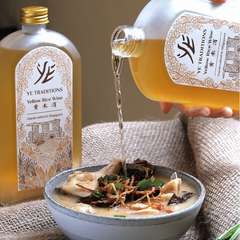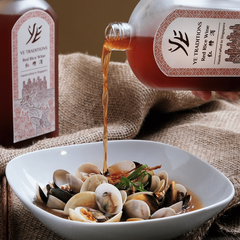What is Shaoxing Wine?
Shaoxing rice wine has been a staple in cooking for centuries. In fact, my family grew up with Shaoxing wine, and would use it at every chance to marinade our dishes.

Why is Salt Added to Shaoxing Wine?
The addition of salt to Shaoxing wine serves multiple purposes. Primarily, salt acts as a preservative, extending the shelf life of the wine by inhibiting the growth of unwanted bacteria during fermentation. This is crucial because the longer fermentation process allows the wine to develop a deeper, more complex flavor profile. Salt also enhances the overall taste of the wine, balancing the sweetness of the rice and highlighting its savory undertones.
The second and probably more important reason is that in many countries, including in Singapore, in order for rice wine to be non-dutiable, the wine needs to have a salt content of 1.5g per 100ml. However, as I mentioned in a previous article, natural fermentation does not have salt as an input nor as an output, so where does the salt come from? That's right, the salt is added to Shaoxing Wines in order to be non-taxable. Otherwise, you would be purchasing this in the alcohol content alongside your wines instead of in the cooking corner.
Because of this, the salt content can be a drawback for those monitoring their sodium intake. Excessive consumption of salt is linked to various health issues, including high blood pressure and cardiovascular disease.
Healthier Alternatives: Red Glutinous and Hakka Yellow Rice Wine
Red Glutinous Rice Wine (Hong Zao Wine) is made from red yeast rice, which gives it a distinctive red color and a unique combination of sweet and tangy flavors. This type of wine is not only beautiful in appearance but also rich in antioxidants, which are beneficial for health. (Shop here)
Hakka Rice Wine, on the other hand, is crafted from a specific glutinous rice variety native to the Hakka regions. This wine is known for its clear, slightly sweet taste and is often used in dishes that require a subtle wine flavor without overpowering other ingredients. (Shop here)

Opt for No-Salt Cooking Wines
While Shaoxing wine remains a popular choice for culinary purposes, its high salt content may not be suitable for everyone. I find it important to educate ourselves about what actually goes into our food since we are feeding them to people we love. By opting for premium no-salt alternatives like red glutinous wine and Hakka Yellow rice wine, you can enjoy the culinary benefits of traditional wines without the health concerns associated with high sodium levels. Next time you step into a grocery store, do keep an eye out!







Leave a comment